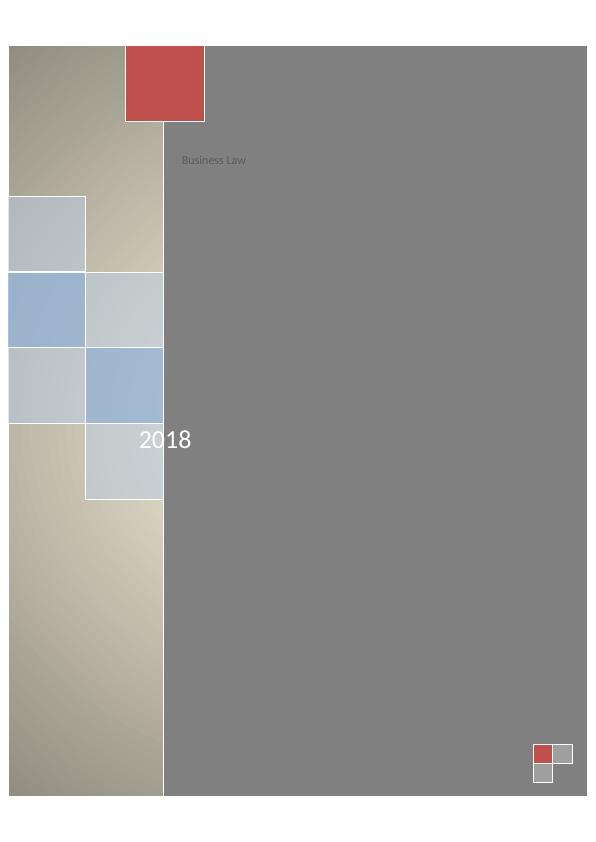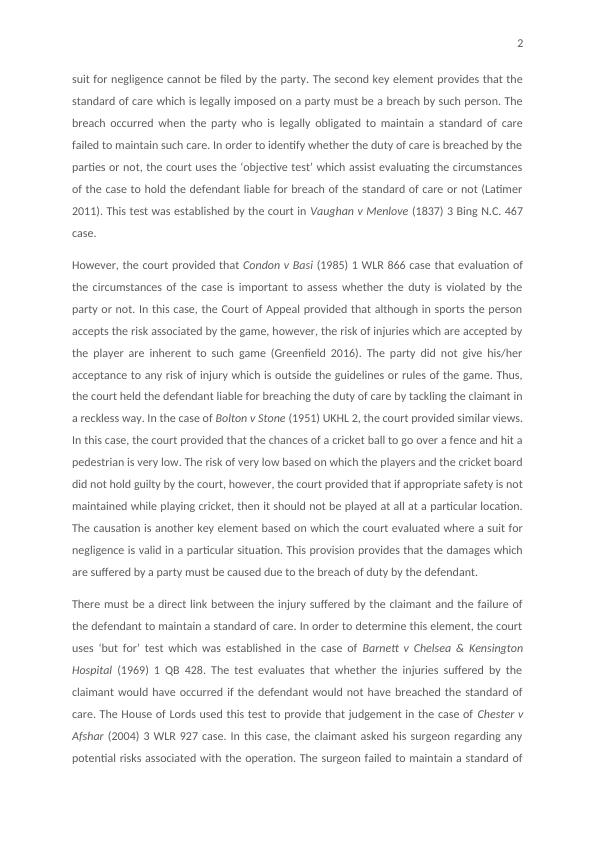Negligence and Liability in Business Law: A Case Study
Added on 2023-06-09
7 Pages2341 Words85 Views
2018
Business Law
Business Law

1
ANSWER ONE
ISSUE
The main issue, in this case, is whether Cliff and Mary can demand damages from Susan for
the loss suffered by them caused due to Benji and whether they can hold Susan liable for
negligence?
RULE
The law of negligence is determined as a civil tort based on which an individual can be liable
for paying damages to another party if he/she failed to maintain a standard of care. The tort
of negligence is a civil liability which provides the right to the innocent party to claim
damages for the loss suffered by the party. The suit of negligence can be filed when a party
breaches the standard of care which is expected by him as per his/her legal obligation. In
Donoghue v Stevenson (1932) AC 562 case, the elements of negligence were given by the
court. The standard of care is a key part which is necessary to be present in order to claim
damages for negligence. The party against whom the suit for negligence is filed must have a
duty of care to ensure that a standard of care is maintained by him. In this case, a person
suffered from a personal injury due to a breach of the duty of care by the café owner. The
claimant drinks the remains of a dead snail which was present in the bottle of ginger beer
which she ordered from the café (Twigg-Flesner 2017). In this case, the key factors of
modern negligence were established by the court. The court provided that the
manufacturer has a duty of care towards its customers to ensure that a standard of care is
maintained by him to avoid causing damages to the party.
The case of Adelaide Chemical and Fertilizer Co Ltd v Carlyle (1940) HCA 44 is a good
example in which the court provided that manufacturer owes a duty of cares to ensure that
the packaging of the products is suitable to avoid causing harm to the customers who use it.
The ‘Caparo test’ is a key test which is used by the court in order to identify whether a
person owed a duty of care or not. It was established by the court in Caparo Industries Plc v
Dickman (1990) 2 AC 605 case. This is a relevant case because it provided the provision
which is used by the court to identify the standard of care of a party. The Caparo test
determines the duty of care based on the proximity established between the relationships
of two parties (Marsh 2017). If there is not sufficient proximity exist between parties, then a
ANSWER ONE
ISSUE
The main issue, in this case, is whether Cliff and Mary can demand damages from Susan for
the loss suffered by them caused due to Benji and whether they can hold Susan liable for
negligence?
RULE
The law of negligence is determined as a civil tort based on which an individual can be liable
for paying damages to another party if he/she failed to maintain a standard of care. The tort
of negligence is a civil liability which provides the right to the innocent party to claim
damages for the loss suffered by the party. The suit of negligence can be filed when a party
breaches the standard of care which is expected by him as per his/her legal obligation. In
Donoghue v Stevenson (1932) AC 562 case, the elements of negligence were given by the
court. The standard of care is a key part which is necessary to be present in order to claim
damages for negligence. The party against whom the suit for negligence is filed must have a
duty of care to ensure that a standard of care is maintained by him. In this case, a person
suffered from a personal injury due to a breach of the duty of care by the café owner. The
claimant drinks the remains of a dead snail which was present in the bottle of ginger beer
which she ordered from the café (Twigg-Flesner 2017). In this case, the key factors of
modern negligence were established by the court. The court provided that the
manufacturer has a duty of care towards its customers to ensure that a standard of care is
maintained by him to avoid causing damages to the party.
The case of Adelaide Chemical and Fertilizer Co Ltd v Carlyle (1940) HCA 44 is a good
example in which the court provided that manufacturer owes a duty of cares to ensure that
the packaging of the products is suitable to avoid causing harm to the customers who use it.
The ‘Caparo test’ is a key test which is used by the court in order to identify whether a
person owed a duty of care or not. It was established by the court in Caparo Industries Plc v
Dickman (1990) 2 AC 605 case. This is a relevant case because it provided the provision
which is used by the court to identify the standard of care of a party. The Caparo test
determines the duty of care based on the proximity established between the relationships
of two parties (Marsh 2017). If there is not sufficient proximity exist between parties, then a

2
suit for negligence cannot be filed by the party. The second key element provides that the
standard of care which is legally imposed on a party must be a breach by such person. The
breach occurred when the party who is legally obligated to maintain a standard of care
failed to maintain such care. In order to identify whether the duty of care is breached by the
parties or not, the court uses the ‘objective test’ which assist evaluating the circumstances
of the case to hold the defendant liable for breach of the standard of care or not (Latimer
2011). This test was established by the court in Vaughan v Menlove (1837) 3 Bing N.C. 467
case.
However, the court provided that Condon v Basi (1985) 1 WLR 866 case that evaluation of
the circumstances of the case is important to assess whether the duty is violated by the
party or not. In this case, the Court of Appeal provided that although in sports the person
accepts the risk associated by the game, however, the risk of injuries which are accepted by
the player are inherent to such game (Greenfield 2016). The party did not give his/her
acceptance to any risk of injury which is outside the guidelines or rules of the game. Thus,
the court held the defendant liable for breaching the duty of care by tackling the claimant in
a reckless way. In the case of Bolton v Stone (1951) UKHL 2, the court provided similar views.
In this case, the court provided that the chances of a cricket ball to go over a fence and hit a
pedestrian is very low. The risk of very low based on which the players and the cricket board
did not hold guilty by the court, however, the court provided that if appropriate safety is not
maintained while playing cricket, then it should not be played at all at a particular location.
The causation is another key element based on which the court evaluated where a suit for
negligence is valid in a particular situation. This provision provides that the damages which
are suffered by a party must be caused due to the breach of duty by the defendant.
There must be a direct link between the injury suffered by the claimant and the failure of
the defendant to maintain a standard of care. In order to determine this element, the court
uses ‘but for’ test which was established in the case of Barnett v Chelsea & Kensington
Hospital (1969) 1 QB 428. The test evaluates that whether the injuries suffered by the
claimant would have occurred if the defendant would not have breached the standard of
care. The House of Lords used this test to provide that judgement in the case of Chester v
Afshar (2004) 3 WLR 927 case. In this case, the claimant asked his surgeon regarding any
potential risks associated with the operation. The surgeon failed to maintain a standard of
suit for negligence cannot be filed by the party. The second key element provides that the
standard of care which is legally imposed on a party must be a breach by such person. The
breach occurred when the party who is legally obligated to maintain a standard of care
failed to maintain such care. In order to identify whether the duty of care is breached by the
parties or not, the court uses the ‘objective test’ which assist evaluating the circumstances
of the case to hold the defendant liable for breach of the standard of care or not (Latimer
2011). This test was established by the court in Vaughan v Menlove (1837) 3 Bing N.C. 467
case.
However, the court provided that Condon v Basi (1985) 1 WLR 866 case that evaluation of
the circumstances of the case is important to assess whether the duty is violated by the
party or not. In this case, the Court of Appeal provided that although in sports the person
accepts the risk associated by the game, however, the risk of injuries which are accepted by
the player are inherent to such game (Greenfield 2016). The party did not give his/her
acceptance to any risk of injury which is outside the guidelines or rules of the game. Thus,
the court held the defendant liable for breaching the duty of care by tackling the claimant in
a reckless way. In the case of Bolton v Stone (1951) UKHL 2, the court provided similar views.
In this case, the court provided that the chances of a cricket ball to go over a fence and hit a
pedestrian is very low. The risk of very low based on which the players and the cricket board
did not hold guilty by the court, however, the court provided that if appropriate safety is not
maintained while playing cricket, then it should not be played at all at a particular location.
The causation is another key element based on which the court evaluated where a suit for
negligence is valid in a particular situation. This provision provides that the damages which
are suffered by a party must be caused due to the breach of duty by the defendant.
There must be a direct link between the injury suffered by the claimant and the failure of
the defendant to maintain a standard of care. In order to determine this element, the court
uses ‘but for’ test which was established in the case of Barnett v Chelsea & Kensington
Hospital (1969) 1 QB 428. The test evaluates that whether the injuries suffered by the
claimant would have occurred if the defendant would not have breached the standard of
care. The House of Lords used this test to provide that judgement in the case of Chester v
Afshar (2004) 3 WLR 927 case. In this case, the claimant asked his surgeon regarding any
potential risks associated with the operation. The surgeon failed to maintain a standard of

End of preview
Want to access all the pages? Upload your documents or become a member.
Related Documents
Can Sophie Sue Michael for Negligence?lg...
|4
|846
|119
Can Susan be held liable for the loss suffered by Cliff and Mary?lg...
|7
|2289
|116
Analysis of Negligence Liability in the Case of Cliff and Mary vs Susanlg...
|7
|2264
|195
Suit for Negligence: Elements, Defences and Applicationlg...
|6
|2401
|444
Can Cliff and Mary recover their damages by filing a suit of negligence against Susan?lg...
|6
|2283
|397
Negligence Tort: Elements and Defenceslg...
|7
|2349
|267
